AMD Kaveri Review: A8-7600 and A10-7850K Tested
by Ian Cutress & Rahul Garg on January 14, 2014 8:00 AM ESTIntegrated GPU Performance: BioShock Infinite
The first benchmark in our test is Bioshock Infinite, Zero Punctuation’s Game of the Year for 2013. Bioshock Infinite uses the Unreal Engine 3, and is designed to scale with both cores and graphical prowess. We test the benchmark using the Adrenaline benchmark tool and their three default settings of Performance (1280x1024, Low), Quality (1680x1050, Medium/High) and Xtreme (1920x1080, Maximum) noting down the average frame rates and the minimum frame rates.
Bioshock Infinite, Performance Settings
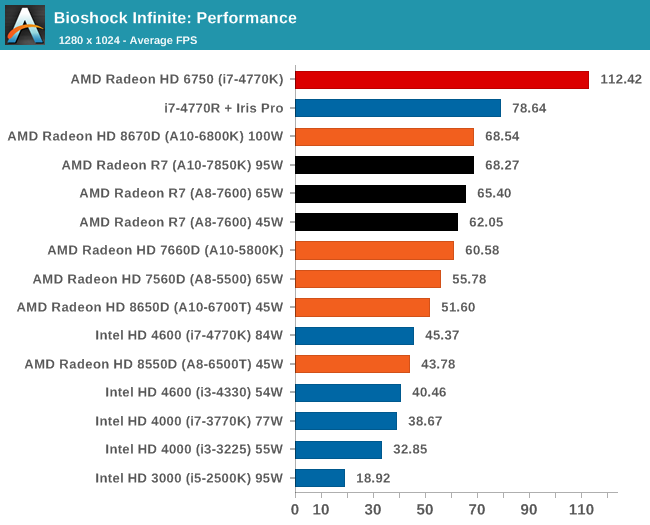
For BI: Performance we see the Iris Pro being top of the IGPs, although the next six in the list are all AMD. The Kaveri cores are all between the 6800K and 5800K for this test, and all comfortably above 60 FPS average.
Bioshock Infinite, Quality Settings

For the quality settings, the Iris Pro starts to struggle and all the R7 based Kaveri APUs jump ahead of the A10-6800K - the top two over the Iris Pro as well.
Bioshock Infinite, Xtreme Settings
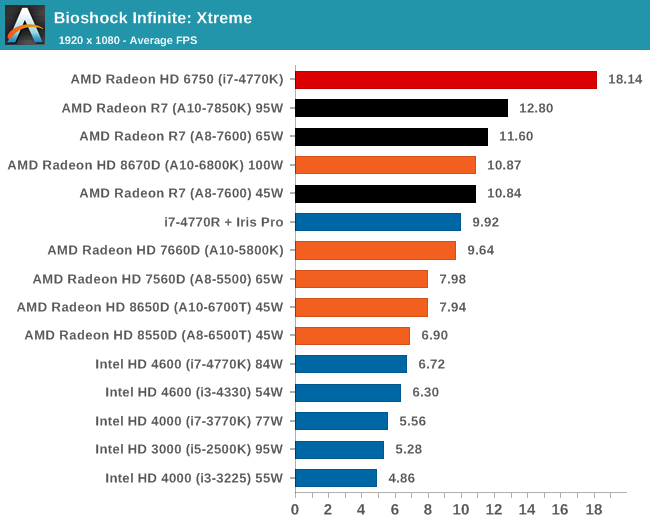
The bigger the resolution, the more the Iris Pro suffers, and Kaveri takes three out of the top four IGP results.
Integrated GPU Performance: Tomb Raider
The second benchmark in our test is Tomb Raider. Tomb Raider is an AMD optimized game, lauded for its use of TressFX creating dynamic hair to increase the immersion in game. Tomb Raider uses a modified version of the Crystal Engine, and enjoys raw horsepower. We test the benchmark using the Adrenaline benchmark tool and their three default settings of Performance (1280x1024, Low), Quality (1680x1050, Medium/High) and Xtreme (1920x1080, Maximum) noting down the average frame rates and the minimum frame rates.
Tomb Raider, Performance Settings
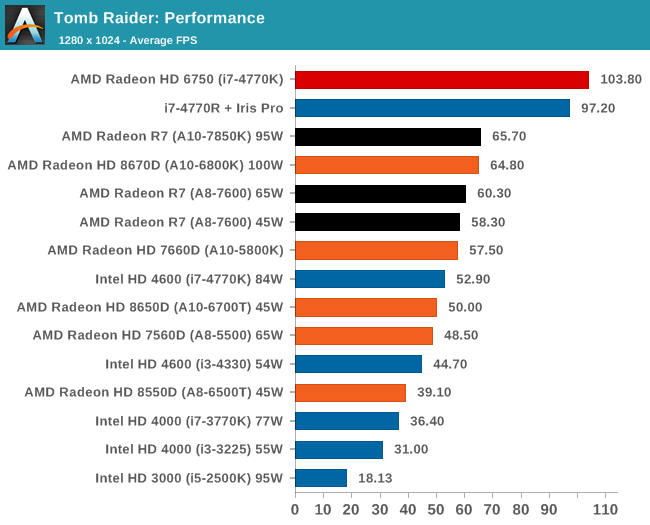
The top IGP for Richland and Kaveri are trading blows in TR.
Tomb Raider, Quality Settings

The Iris Pro takes a small lead, while the Kaveri 95W APU show little improvement over Richland. The 45W APU however is pushing ahead.
Tomb Raider, Xtreme Settings
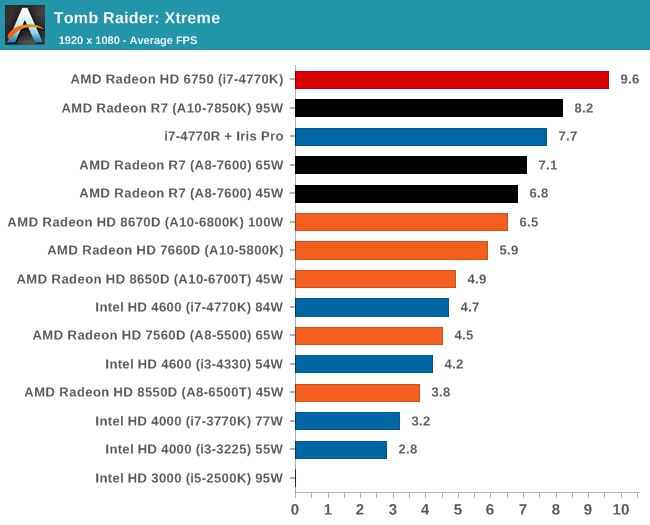
At the maximum resolution, the top Kaveri overtakes Iris Pro, and the 45W Kaveri it still a good margin ahead of the A10-6700T.
Integrated GPU Performance: F1 2013
Next up is F1 2013 by Codemasters. I am a big Formula 1 fan in my spare time, and nothing makes me happier than carving up the field in a Caterham, waving to the Red Bulls as I drive by (because I play on easy and take shortcuts). F1 2013 uses the EGO Engine, and like other Codemasters games ends up being very playable on old hardware quite easily. In order to beef up the benchmark a bit, we devised the following scenario for the benchmark mode: one lap of Spa-Francorchamps in the heavy wet, the benchmark follows Jenson Button in the McLaren who starts on the grid in 22nd place, with the field made up of 11 Williams cars, 5 Marussia and 5 Caterham in that order. This puts emphasis on the CPU to handle the AI in the wet, and allows for a good amount of overtaking during the automated benchmark. We test at three different levels again: 1280x1024 on Low, 1680x1050 on Medium and 1920x1080 on Ultra. Unfortunately due to various circumstances we do not have Iris Pro data for F1 2013.
F1 2013, Performance Settings
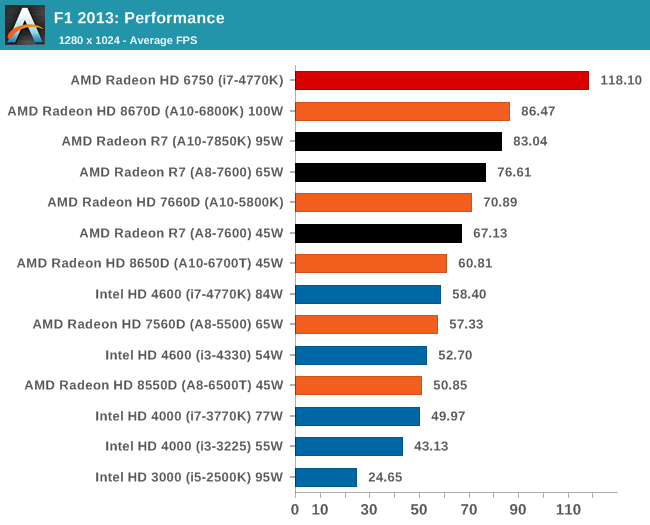
F1 likes AMD here, although moving from Kaveri to Richland at the high end seems a bit of a regression.
F1 2013, Quality Settings
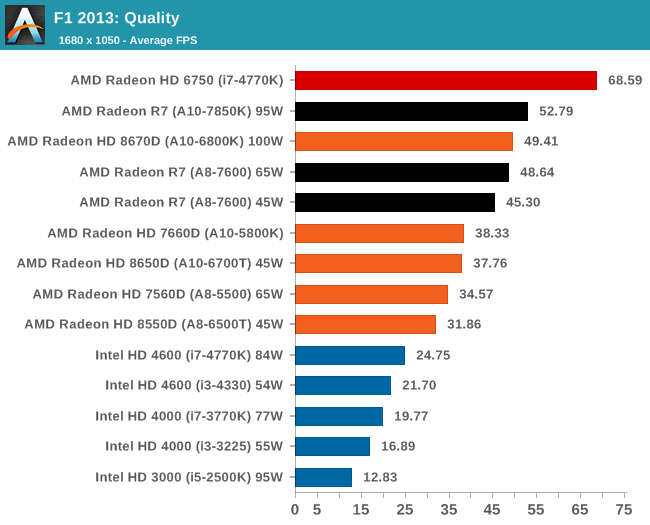
Similarly in the Quality settings, none of the Intel integrated graphics solutions can keep up with AMD, especially Kaveri.
F1 2013, Xtreme Settings

On extreme settings, at 1080p, the top Kaveri APU manages to hit over 30 FPS average during the benchmark. The other A8 Kaveri data is not too far behind.










380 Comments
View All Comments
YuLeven - Tuesday, January 14, 2014 - link
So a cheap Pentium / Athlon CPU paired with a dGPU costs less and gives more gaming performance. Yaaaaaaaaaawn AMD.thomascheng - Tuesday, January 14, 2014 - link
yeah, I agree, these type of benchmarks doesn't paint a proper picture in the same category. It's like a Ferrari vs Honda Civic. The Ferrari wins, but cost a lot more. At least have a price to performance benchmark, which is much more useful.Bob Todd - Tuesday, January 14, 2014 - link
If it wasn't clear from the article, the dGPU setup doesn't need that 4770K to be the fastest. You could buy a cheap dual core Pentium + 7750 for under $170 and still be in the same position. The only good news I see from a quick scan through the article is the A8-7600 @ 45W, mostly because there may be some hope of decent mobile parts that can do 720p gaming.YuLeven - Tuesday, January 14, 2014 - link
In fact, as of today you can buy a Pentium + HD 7770GE for US$175~ on Newegg.thomascheng - Tuesday, January 14, 2014 - link
if Mantle and True Audio takes off, I think the apu would be a better deal. Plus you get a smaller form factor and better support for the new technologies.YuLeven - Tuesday, January 14, 2014 - link
The HD 7770GE is a GNC part, so it has mantle. This renders the APU even less compelling.Bob Todd - Tuesday, January 14, 2014 - link
As YuLeven already pointed out, you can get much faster GCN dGPUs for the same price. But I'll go ahead and discredit the 'smaller form factor' advantage. AMD is nearly non-existent in mini ITX. There are a whopping 2 FM2+ mITX boards on Newegg (and only 2 more FM2). It's so bad that Newegg doesn't even expand the "Form Factor" filter by default for AMD, but they do for Intel (who has 24 mITX boards just for LGA 1150).Like I said, I have some (tiny) hope for mobile Kaveri to enable 720p gaming in a portable package, but even there I am worried about idle power consumption compared to Haswell. For desktop, Kaveri looks like a bust since even niches like htpc gaming aren't in the realm of possibility at 1080p.
drezden444 - Tuesday, January 14, 2014 - link
Well. Good step forward, but yet a small step. The part about 45W improvement is really a good one. And obvious AMD can have an excellent notebook APU. I think we may have 35W 2.8-3GHz notebook A8 APU. Question. What about overclock. I'll be delighted to know whether this CPU has a potential. And keep in mind that I may buy 760K(overclock it between 4.5-5.1GHz) and 7750(or even maybe 7770) for the same money. So, what about this $ numbers.YuLeven - Tuesday, January 14, 2014 - link
What I want to see on Kaveri's mobile appearance is power consumption. Trinnity had a decent GPU, but the designs it won gave you pathetic 3 hour of WiFi battery life. Trinnity ULV was awfully slow and nowhere close to Haswell's battery offerings. If Kaveri keeps like this, it will end again only inside boring, thick, hot and loud budget 'gaming' notebooks.drezden444 - Tuesday, January 14, 2014 - link
True! But I'm really impressed by a6-5200 bobcat 25W. This is a CPU with a potential bigger than Kaveri. I'm kinda thinking, if they just merge both APUs into 1 much better. And still, Kaveri 35W 2,8GHZ for budget 'gaming' laptops will be a good deal for gaming at 1366*768.